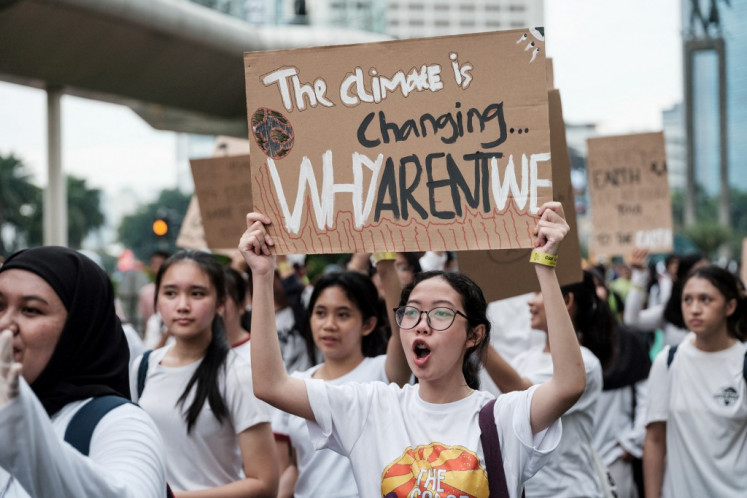Land swaps for peatland restoration?
The government deserves high praise for its numerous commitments to protect and restore peatland over the past years
Change Size

T
he government deserves high praise for its numerous commitments to protect and restore peatland over the past years.
At the start of this year, the Environment and Forestry Ministry (KLHK) announced Ministerial Regulation No. 40/2017 regarding government facilitation of Industrial Tree Concessions (HTI) within the framework of the management and protection of peat ecosystems.
While the 2016 regulation on the management and protection of peatland obligates the enterprises to protect peat areas under conservation status, the latter provides a compensation scheme for HTI companies by allowing them to seek a land swap — to obtain substitute land for their working areas that falls into conserved peat ecosystem category.
This ministerial regulation states that HTI concessions containing peatland of at least 40 percent or more under the conservation function may apply for a land swap to be facilitated by the ministry.
Based on this criteria, surely concessions on peat domes should be considered highly potential for land swaps. Data from the Peatland Restoration Agency (BRG) shows at least 119,045 hectares of HTI concessions on peat domes within BRG’s restoration area as regulated by the Presidential Regulation No. 1/2016.
The swap constitutes changing the working area specified in the existing permit to a similarly sized area on mineral soil zoned for production forest at an adjacent or different location.
However the responsibilities to manage and protect both existing and newly-obtained substitute land lie with the concession holders. A company’s application must include a map of the proposed substitute working area and verification of its social and environmental feasibility for production, as well as a notarized statement of the company’s ability to protect the peatland ecosystem within its former working area.
To understand land swaps, we can think of them as having several layers:
Land status swap — this refers to a change in legal classification. In Indonesia, land is primarily distinguished between Forest Estate (Kawasan Hutan) and Non-Forest Estate (APL). Land status swaps between Forest Estate and Non-Forest estate require coordination between multiple ministries and local government agencies, and are administratively and politically difficult. However, within the sub-classifications of the Forest Estate there are several common policy mechanisms for land status swaps.
Permit swap — this refers to changing the working area of a land use permit. The previous location could then be kept and managed more sustainably, or changed to a different land use entirely if the land status is changed as well.
Management swap — this refers to changing use management to be more sustainable, rather than changing location or land status. This is relevant to areas that can be managed for conservation or sustainable forest activities, either by the company with a permit or another party.
Land swaps have long been discussed as a potential mechanism for the oil palm sector to improve sustainability by complying to the Roundtable for Sustainable Palm Oil (RSPO) or voluntary commitments to zero deforestation/zero peat. Within BRG’s peatland restoration area, oil palm concessions or HGU on peat domes cover 310,435 ha, which would potentially require a land swap of some form to make restoration efforts successful.
However, since oil palm production permits are issued by the Agriculture Ministry and technically can only be developed on Non-Forest Estate land, finding alternative land to swap is complicated. Limited availability of non-forest estate land that is not forested, contains no peatland and has no existing claims or other production can be a barrier in some regions.
Likewise, many oil palm companies perceive land swaps to be difficult, time consuming and posing too great a risk for them to even consider. Rather, the focus of the sustainable oil palm industry has been finding management options for conserving high conservation value areas within their concessions that they cannot develop to be in accordance with RSPO criteria and other sustainability commitments.
Protecting and restoring Indonesia’s peatlands will certainly require diverse management and policy mechanisms, and land swaps may well be a viable solution in the case of HTI.
Land swaps for HTI concessions should be significantly less complicated than they would be for the oil palm industry, as they would not require a legal status change.
But many questions remain. How sizable will the impact of Ministerial Regulation No. 40/2017 be on peat restoration efforts overall, including those of the BRG? Will it be feasible to implement within the rapid time frame needed? What are the limits and risks of this regulation?
To gauge the potential impact of this policy on our peatland management, we also need to better understand how the Ministry will incentivize or enforce companies to participate in this scheme.
When management and protection responsibility remains intact for both original and newly obtained land-swap areas, would it provide necessary motivation for the HTI companies? Is there sufficient infrastructure available on the newly obtained land to allow companies to justify this scheme from a business and cost perspective?
An incentive scheme can surely be developed, and despite doubts, this regulation is an encouraging step in finding practical solutions for peatland protection. But it will require close attention from peatland advocates to ensure progress and enforcement is happening on the ground.
_______________________________
Lisa Johnston is research associate at World Resources Institute and Nirarta Samadhi is country director of World Resources Institute Indonesia.









